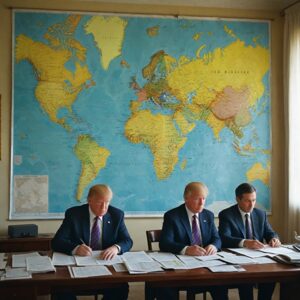Summary
India’s foreign exchange reserves surged by approximately USD 27 billion to reach a record USD 698.1 billion in early 2024, marking a significant weekly increase driven largely by strategic interventions from the Reserve Bank of India (RBI), including a USD 10 billion forex swap. This robust growth follows a period of fluctuation influenced by investor sentiment and market dynamics, underscoring the RBI’s active role in managing currency stability and ensuring adequate liquidity in the economy. The reserves, comprising foreign currency assets, gold, Special Drawing Rights (SDRs), and the country’s IMF reserve position, serve as a vital buffer against external shocks and support India’s economic resilience.
India’s forex reserves have grown substantially over the past decades, evolving from a precarious position in the early 1990s—when reserves barely covered three weeks of imports—to becoming the fourth-largest globally. This transformation reflects the impact of economic liberalization policies initiated in 1991, prudent fiscal management, and the RBI’s strategic interventions to stabilize the rupee amid global financial volatility. The current reserves provide an import cover of around 11 months, signaling strong external sector health and capacity to withstand international economic uncertainties.
The recent surge in reserves is notable not only for its size but also for its timing amid fluctuating global capital flows and geopolitical tensions. Analysts highlight that the increase strengthens India’s external position by enhancing liquidity and supporting the currency, while diversification of reserve assets helps mitigate risks associated with reliance on U.S. dollar holdings. Economists regard this development as a positive indicator of India’s financial stability, improved investor confidence, and the effectiveness of the RBI’s market interventions.
Despite the favorable outlook, challenges remain, including potential volatility in global capital movements and exchange rates. The RBI continues to monitor these risks closely, employing diversified reserve management strategies to safeguard India’s economic sovereignty. The surge in forex reserves thus exemplifies India’s growing integration into global financial markets and its ongoing efforts to maintain macroeconomic stability amid an evolving international landscape.
Background
India’s foreign exchange reserves consist of holdings such as cash, bank deposits, bonds, and other financial assets denominated in currencies other than the Indian rupee. These reserves are managed by the Reserve Bank of India (RBI) on behalf of the Indian government, with foreign currency assets forming the main component. The reserves play a crucial role in facilitating external trade and payments, while also supporting the orderly development and maintenance of the foreign exchange market in India.
The management of these reserves involves a balanced portfolio that includes foreign currencies, gold reserves, special drawing rights (SDRs), and the reserve position in the International Monetary Fund (IMF). These components are carefully calibrated to respond to various economic scenarios, thereby ensuring financial stability and contributing to economic growth.
India’s approach to economic reforms, initiated in July 1991, marked a significant turning point in addressing macroeconomic stabilization and structural adjustments. The reforms aimed to restore balance of payments equilibrium and control inflation through measures such as fiscal discipline and opening up the economy towards a market-oriented framework. This process helped strengthen the foundation for managing the country’s foreign exchange reserves effectively.
The RBI plays an active role in controlling India’s forex reserves by closely monitoring foreign exchange markets and intervening as necessary to maintain market stability and prevent excessive fluctuations in exchange rates. Notably, such interventions occur without a predetermined target or range, allowing flexibility in response to evolving market conditions.
As of late 2024, India’s total foreign exchange reserves have shown considerable growth, reflecting the resilience and strategic management of these assets by the RBI and the government.
Recent Surge in Forex Reserves
India’s foreign exchange reserves experienced a significant surge, increasing by approximately USD 27 billion to reach USD 698.1 billion, marking an impressive week of growth. This rise follows a previous decline of USD 1.781 billion that had reduced the reserves to USD 638.7 billion. A major contributor to this boost was a USD 10 billion forex swap executed by the Reserve Bank of India (RBI) on February 28, alongside other strategic interventions by the central bank.
Over the past three weeks, the reserves have cumulatively increased by USD 20.1 billion, with about USD 6.6 billion added in the latest reporting week. Experts attribute the earlier declines in reserves to shaken investor confidence in Indian equity markets, while the recent growth reflects the RBI’s active market interventions and improved capital inflows.
Foreign currency assets, which form the largest portion of India’s reserves, also rose by USD 1.739 billion to USD 589.426 billion in the latest week. The gold component of the reserves increased by USD 428 million to USD 86.316 billion, reflecting a global trend of central banks accumulating gold as a safe-haven asset amid geopolitical uncertainties. Special Drawing Rights (SDRs) increased by USD 85 million to USD 18.76 billion, and India’s reserve position with the International Monetary Fund (IMF) saw a modest rise to USD 4.502 billion.
Economists consider the current level of forex reserves as more than adequate to cover external vulnerabilities, noting that India’s external metrics remain healthy with a low current account deficit and manageable external debt. The recent surge is also supported by the maturity of dollar/rupee swaps and fresh dollar purchases by the RBI, enhancing the country’s ability to withstand external volatility.
Global Economic and Capital Flow Context
India’s foreign exchange reserves and capital flows have been significantly influenced by both domestic policy measures and global economic conditions over the past two decades. Despite a gradual and staggered liberalization of capital controls, India has witnessed several surges and reversals in capital flows, particularly following the global financial crisis (GFC). This volatility reflects the evolving nature of the foreign investor base and the increasing importance of different types of investors in India’s debt and equity markets.
The structure of India’s forex reserves is diversified and carefully managed to ensure a balanced portfolio capable of responding to various economic scenarios. These reserves are subject to fluctuations driven by central bank interventions in forex markets as well as changes in the valuation of foreign assets due to currency appreciation or depreciation.
Global economic factors play a critical role in shaping the trajectory of India’s forex reserves. The overall state of the world economy affects foreign investment flows, trade balances, and subsequently the accumulation or depletion of forex reserves. For instance, global financial volatility and external shocks often prompt the Reserve Bank of India (RBI) to deploy its reserves strategically to stabilize the domestic currency, as seen in recent years.
Moreover, the evolving global investor base, including the growing prominence of sustainable finance, has implications for emerging markets like India. The presence of diverse investor types in both equity and debt markets can influence the stability and sustainability of capital flows. This dynamic, combined with internal banking sector trends such as the rising loan-to-deposit ratio, also affects credit growth and the broader financial environment.
India’s foreign exchange reserves rank among the largest globally, holding the fourth position after China, Japan, and Switzerland as of September 2021. The accumulation and management of these reserves are governed by the Reserve Bank of India Act and the Foreign Exchange Management Act, 1999, with the RBI actively purchasing foreign currency from authorized dealers to maintain reserve levels. In October 2021, reserves reached an all-time high of USD 645 billion before moderating due to interventions aimed at defending the rupee against global pressures.
Impact of the Surge
The recent surge in India’s foreign exchange reserves by $27 billion to reach approximately $698.1 billion has significant implications for the country’s economic stability and growth prospects. One immediate impact of this increase is the enhancement of import cover, which currently stands at around 11 months—consistent with the average over the past two decades—providing a strong buffer against external shocks and ensuring the smooth functioning of international trade. This level of reserves not only safeguards the Indian rupee but also reflects the country’s disciplined financial management and resilience in the face of global uncertainties.
This boost in reserves is partly attributed to strategic interventions by the Reserve Bank of India (RBI), including a $10 billion forex swap, which demonstrates proactive liquidity management to stabilize the currency and support economic expansion. The RBI’s monetary policy aims to maintain price stability, control inflation, and preserve adequate foreign exchange reserves, all of which are crucial in fostering investor confidence and sustaining economic growth. By managing volatility in the forex market through both buying and selling of dollars, the RBI helps maintain a stable exchange rate, thereby supporting export competitiveness and curbing inflationary pressures.
Furthermore, the surge strengthens India’s position against global financial uncertainties and geopolitical risks. The RBI has been actively diversifying its foreign exchange portfolio across various currencies, asset classes, and jurisdictions to mitigate potential external shocks and enhance liquidity and returns. This diversification strategy, coupled with growing forex reserves, enhances India’s economic sovereignty and its ability to respond to global economic challenges, such as fluctuating commodity prices and international crises.
From a macroeconomic perspective, robust forex reserves contribute to the overall health of the Indian economy by underpinning fiscal discipline and supporting ongoing reforms initiated since the early 1990s to liberalize and open the economy. The improved reserve position provides the government and the RBI with greater flexibility in implementing monetary and fiscal policies that can stimulate growth while keeping inflation in check. This, in turn, promotes a stable investment climate, crucial for attracting capital flows and sustaining India’s economic momentum in an increasingly interconnected global market.
Historical Context
India’s foreign exchange reserves have undergone significant transformation over the past few decades, shaped by critical economic events and policy reforms. In the late 1980s and early 1990s, India faced a severe Balance of Payments (BoP) crisis driven by unsustainable borrowing, high fiscal deficits, and a widening current account deficit that reached about 3.5 percent of GDP in 1990-91. By January 1991, India’s forex reserves were dangerously low, at approximately USD 1.2 billion, enough to cover barely three weeks of essential imports, placing the country on the brink of defaulting on its external obligations. This crisis underscored the urgent need for comprehensive economic reforms.
In response, the Indian government introduced a landmark set of economic reforms in July 1991 aimed at macroeconomic stabilization and structural adjustment. These reforms targeted fiscal discipline by addressing the large fiscal deficit, which was 8.4 percent of GDP in 1990-91, and rationalized exchange rate policies, including a substantial devaluation of the rupee by around 20 percent to boost export competitiveness. The reforms dismantled the restrictive License Raj system, eased regulatory controls, and opened the economy to foreign investment and trade, shifting India from a Soviet-style economy toward a market-oriented one.
Over time, these reforms laid the foundation for sustained growth in India’s forex reserves. The combination of increased foreign direct investments, growth in IT and service exports, and prudent economic management contributed to the steady accumulation of reserves. India’s reserves now provide a robust buffer, covering approximately 10 to 11 months of projected imports, reflecting improved economic resilience compared to the precarious position in 1991. The growth in reserves also indicates India’s deeper integration with global financial markets, supported by ongoing policy adaptations and regulatory reforms.
This historical evolution highlights how India transformed its forex reserve position from near collapse in 1991 to becoming one of the world’s largest holders of foreign exchange assets, a trajectory marked by critical policy decisions and economic liberalization.
Reactions and Analysis
The recent surge in India’s foreign exchange reserves to $698.1 billion has been met with positive assessments from economists and financial analysts, who emphasize the adequacy and strategic importance of the reserve buildup. Gaura Sen Gupta, an economist at IDFC FIRST Bank, noted that India’s external metrics remain healthy, characterized by an adequate level of reserves combined with a low current account deficit and low external debt levels. Gupta further highlighted that the current level of reserves is “more than adequate,” providing a substantial buffer against external volatility. The recent increase in reserves was significantly influenced by the maturity of a $5 billion dollar/rupee swap and a $10 billion forex swap executed by the Reserve Bank of India (RBI) in late February, which helped reverse a prior decline in reserves.
Economists also observe a marked improvement in India’s import cover due to the reserve buildup. Since October 2022, the equivalent months of import cover provided by the reserves (including spot and forward assets) rose from approximately 8.9 months to 10.4 months, signaling enhanced external sector resilience. Vivek Kumar of QuantEco Research commented that the RBI is likely to continue leveraging opportunities to further bolster import cover. Additionally, RBI interventions in the spot and forward foreign exchange markets have resulted in a muted rupee response to the dollar’s decline, suggesting effective management of currency volatility amid global financial uncertainties.
From a broader perspective, the accumulation and management of forex reserves in India reflect a strategic approach aligned with both domestic economic priorities and global financial integration. The Reserve Bank of India, in consultation with the Government of India, takes calculated decisions on currency composition and asset allocation within the reserves to optimize returns and risk management. This approach is informed by a combination of factors including global uncertainties, domestic economic conditions, and national security considerations, as outlined in earlier policy frameworks. Such strategic management underlines that changes in foreign exchange reserves are not arbitrary but are part of a deliberate policy to maintain liquidity at risk and ensure reserve adequacy in a complex international environment.
Future Outlook
India’s foreign exchange reserves are expected to maintain a robust position in the near to medium term, supported by a combination of strong capital inflows, strategic Reserve Bank of India (RBI) interventions, and favorable global economic conditions. S&P Global projects that wider index inclusion could significantly enhance foreign participation in India’s government bond market, potentially increasing foreign holdings from 0.9% in 2023 to 10% by 2030. This development is likely to nearly triple the funds available for corporate debt issuers relative to nominal GDP, which would provide a substantial boost to India’s financial markets and external liquidity.
Despite the inherent volatility of capital flows, which have surged and reversed multiple times over the past two decades, India’s gradual and cautious capital liberalization has helped stabilize inflows and broaden the investor base. This evolving dynamic implies that India, like other emerging markets, will need to navigate the increasing role of diverse types of foreign investors in both its debt and equity markets, while leveraging the global growth in sustainable finance to attract more long-term investments.
The RBI’s continued focus on maintaining a healthy forex buffer is expected to sustain investor confidence and support the Indian rupee amidst global headwinds. Currently, India’s reserves can cover approximately 11 months of imports and 96% of its external debt, signaling strong external resilience. However, fluctuations in exchange rates, geopolitical tensions, and international crises will remain key risk factors influencing reserve levels.
To mitigate such risks, the RBI is prioritizing diversification of reserve assets across multiple currencies, asset classes, and jurisdictions. This strategy aims to enhance the safety, liquidity, and return of reserves, especially given the current heavy reliance on U.S. dollar assets and Treasury securities. The experiences of other countries facing geopolitical uncertainties, such as Russia’s recent challenges with sanctioned gold assets, underscore the importance of such diversification measures for India’s future reserve management.


























